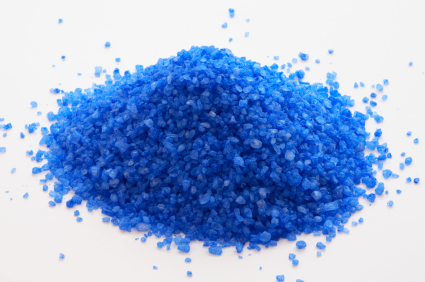Epsom salt baths/foot soaks
In addition to Heidi's visits to her chiropractic neurologist after she began her first medical leave of absence ten days after suffering a concussion playing hockey at school, we also took Dr. K's suggestion that Heidi use good old fashioned Epsom salts (magnesium sulfate), either as part of a bath therapy or as a foot soak.
Epsom salts turned out to be a simple, yet remarkably helpful, therapy, one which Heidi continued to use over the entire course of her recovery. As a hassled parent, I found foot soaks to be less of a nuisance with an irritable patient, as I could make Heidi soak her feet if she brought me the bucket; I couldn't make her undress and get in the tub! 
Based on my subsequent research, it appears Epsom salts help in concussion recovery for several reasons. From a groundbreaking 2001 study1 by researchers at UCLA, I learned that the biology of concussion involves a cascade of damaging calcium ion releases, which the magnesium in the Epsom salts likely helps counteract (although fundamental research on mineral supplements is typically old, and no pharmaceutical company or biochemistry department is likely going to spend big bucks promoting the use of magnesium sulfate any time soon!).
I also found out that magnesium is a known treatment for migraine and helps to promote sound sleep, and that sulfates are necessary for proper brain function with respect to behavior, mood and function. Reduced sulfation has been shown in a study by researchers at the University of Birmingham (UK) to play a role in brain dysfunction, such as Parkinson's Disease.
While more research is needed specific to concussion, the use of Epsom salts was a sensible, non-invasive, inexpensive home remedy that made Heidi feel good and we felt it couldn't hurt (Besides, floating in a bathtub reduces the strain on the brain in counter-acting the pull of gravity). Whenever Heidi was having a really bad day, a warm (not hot) bath with Epsom salts always helped.
Her sports doctor, Dr. S., later concurred with this therapy, which I now personally advocate, parent to parent, as standard first aid right after a concussion, and as a continuing therapy for the five to ten percent of concussion victims whose symptoms linger for six weeks or longer (the point at which post-concussion syndrome is generally considered to begin).
Craniosacral therapy
In the first month after her concussion, Heidi also tried another therapy, as she began undergoing craniosacral therapy (CST) (another by-product of my continuing research on the Internet).
CST is a 20th century offshoot of cranial osteopathic medicine, a philosophy and system of healing first proposed by Dr. A. T. Still in 1874. Osteopathic medicine emphasizes the interrelationship between structure and function of the body and recognizes the body's ability to heal itself. It is the role of the osteopathic practitioner to facilitate that process.
Among the many elements of CST, the one which caught my untrained eye, was the CST view that the normal cranial system of plates, sutures and membranes in the skull should have mobility, i.e. the capacity to "breathe." I later learned that head injuries and concussion can affect multiple components of the craniosacral system, including abnormal membranous tensions (a common clinical presentation), bone articulations (e.g. cranial sutures) and sutural immobility. These adversely affect the free flow and stable pressure of cerebro-spinal fluid (CSF), blood flow, neural conduction and numerous other physiologic functions.
As Heidi's other non-invasive treatments continued, I also learned that CST is a very comprehensive therapeutic approach, and that it treats each patient as an individual (in the same way that each concussion is unique). Because of the structural continuity of the body, CST diagnostics and treatment extend beyond the craniosacral system for an integrative approach to pain and dysfunction as it presents anywhere in the body.
CST is fundamentally an approach that encourages the body to heal itself, but it is not a quick fix. Just like every other aspect of concussion, the body and brain need time to do the work of healing in response to CST. Although CST is considered somewhat outside the mainstream, some leading sports physicians treating concussion (and the various symptoms that appear with concussion such as vertigo, headache, musculoskeletal pain, vision and hearing changes to name a few) now refer patients to CST, sometimes with impressive results.
Heidi found that CST helped. After three sessions her physical symptoms were less severe, but, unfortunately, the therapist she was seeing was moving her practice to Canada and Heidi had to temporarily discontinue treatment. (There is much more to be said about CST, but I will leave it to another article.)
Part Four of "Unmarked Detour."
For more in this series, click here.
For a page listing related video segments featuring Dorothy Bedford, click here.
1. Giza CC, Hovda DA, The Neurometabolic Cascade of Concussion. J. Ath Train 2001;36(3):228-235.
Dorothy Bedford is a mother of three from Princeton, New Jersey.








